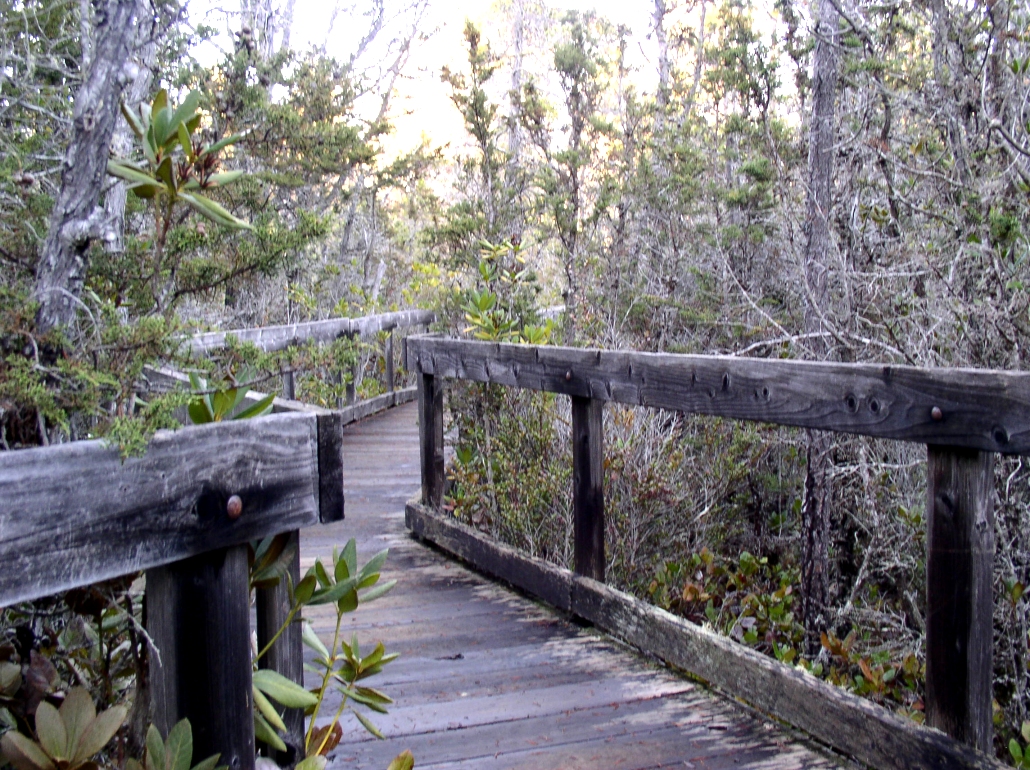
|
|
|
Lottie's Pygmy Forest Blog: What is the Pygmy Forest?
The term "pygmy forest" has been used since the mid-eighteen hundreds to describe two different kinds of places. The first usage denoted jungles where tribes of African natives of very short stature lived. That usage has fallen out of favor, especially after it came to light in 1906 that a Congolese man, Ota Benga, of the Mbuti race, was captured and put on display in an animal cage at the Bronx Zoo. Now, "Pygmy Forest" means a woodland area in which trees and plants are stunted by natural environmental conditions. The best known pygmy forests are located in Sonoma and Mendocino counties along the Northern California Coast. These pygmy forests occur in scattered pockets next to normal coastal pine and redwood forests.

|
|
|
The pygmy forest consists primarily of Pygmy Cypress, Bolander and Bishop pine trees, rhododendron, huckleberry, manzanita, Labrador Tea and other perennial shrubs. They grow adjacent to regular sized forests where the same types of plants grow to their full, genetically inherent sizes. Full grown cypress trees, at 80 years, often grow 100 feet tall while their pygmy forest cousins only attain heights of 2 to 10 feet or less. Other plants in the pygmy forest are similarly stunted.
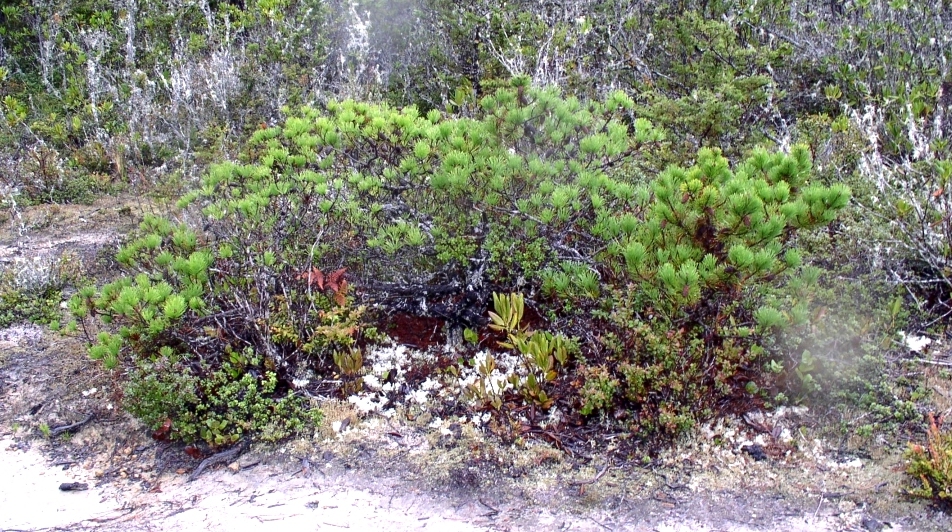
|
|
|
Several environmental factors limit the growth of pygmy forest plants. The soil has been depleted of most of it's nutrients by hundreds of thousands of years of leaching by seasonal rain. Much of pygmy forest land is under water for up to six months of the year from the accumulation of heavy seasonal rains and a lack of drainage. Eighteen inches below the surface, a cement-like consolidation of iron and sand, called "hard pan", has formed to block tree roots from penetrating into the rich subsoil deeper in the earth. A toxic concentration of aluminum and acid remains in the soil creating conditions that only a few types of plants can survive. Pygmy soil is almost as acidic as lemon juice.
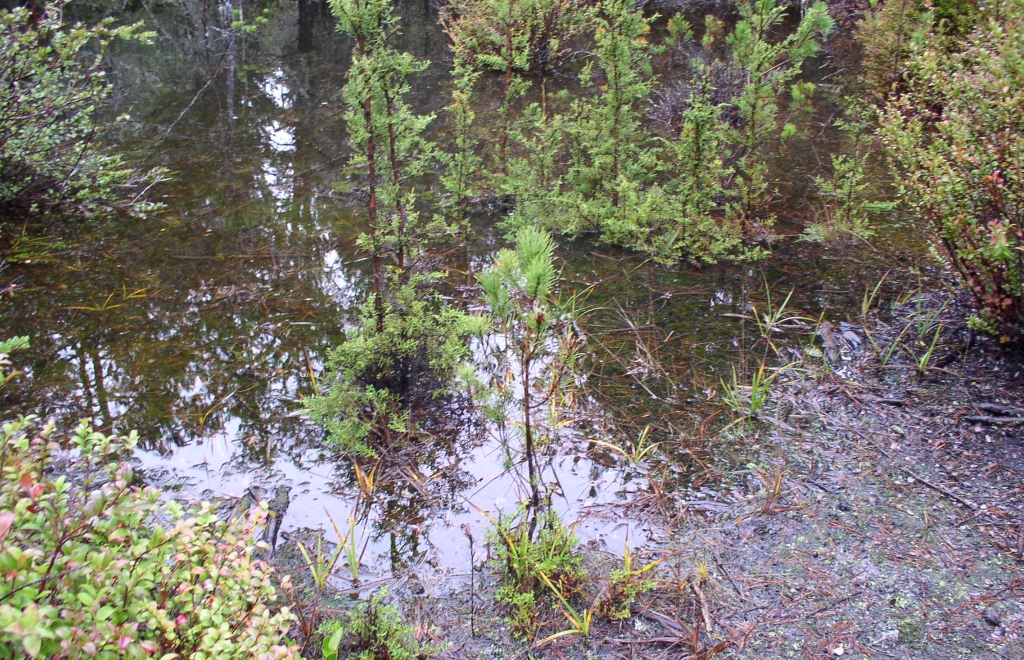
|
|
|
Geologic evolution of the pygmy forest is unique and bears explanation. The earth under these pygmy forests has evolved by a gradual rising of the land by about one foot every thousand years, reaching an altitude of 650 feet above sea-level after half a million years. About every 100,000 years, during epochs of glacial melt, swollen seas batter the shoreline creating 150 foot tall cliffs and 3/4 mile long, plateaus covered with cliff-side rubble. As the land was thrust upward and the seas receded during ice ages, a series of five terraces have evolved which resemble steps. This is now referred to as an ecologic staircase. The first and lowest step consists of grassland. With every step... each 100 foot rise in elevation... each 3/4 mile setback from the sea... different types of ecosystems have developed. Pygmy forest exists on parts of the third, fourth and fifth steps. Any link between the tectonic formation of the staircase and the stunted characteristic of pygmy forests is unclear.
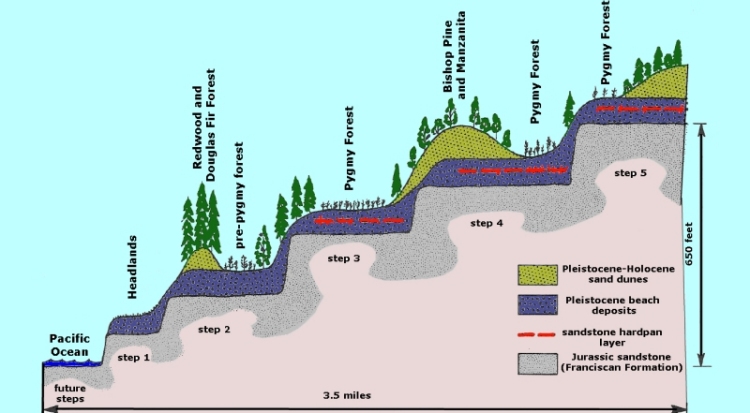
|
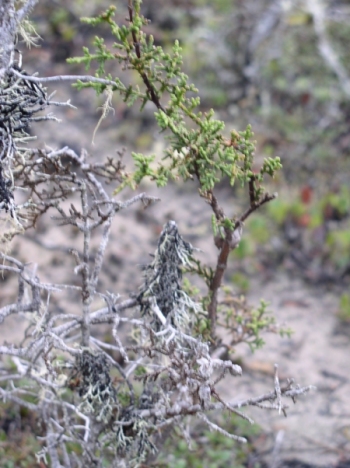
|
The outcome of all of these conditions is that plants grow very slowly, and very little. They are easily damaged by seasonal floods and disease. Some of the stunted pygmy plants are fully clothed in normal foliage but many exhibit dead leaves, limbs, needles and branch tips. Microorganisms that normally digest expired plant matter into compost are few, and the ground is littered with lichen covered tree trunks & pine needles. These slowly break into pieces and eventually wash away. Entire plants are dead and standing, but, many more only "appear" to be dead at first glance. A closer look often reveals the smallest of living twigs attached to an otherwise dead tree or shrub. This is evidence of their struggle to absorb enough food, air and clean water to survive another season. For these plants, conditions are hostile. Yet, by some scientifically unaccountable force of nature, the pygmy forest retains a green canopy.
Trails are common throughout the pygmy forest and often serve as water courses in the winter. The trails, made by deer perhaps, or human huckleberry gatherers, zig-zag, double back and wind around like a maze. Dense brush blocks any sight of the horizon. Until one has walked over the same trail numerous times there are no obvious landmarks to aid in navigation.
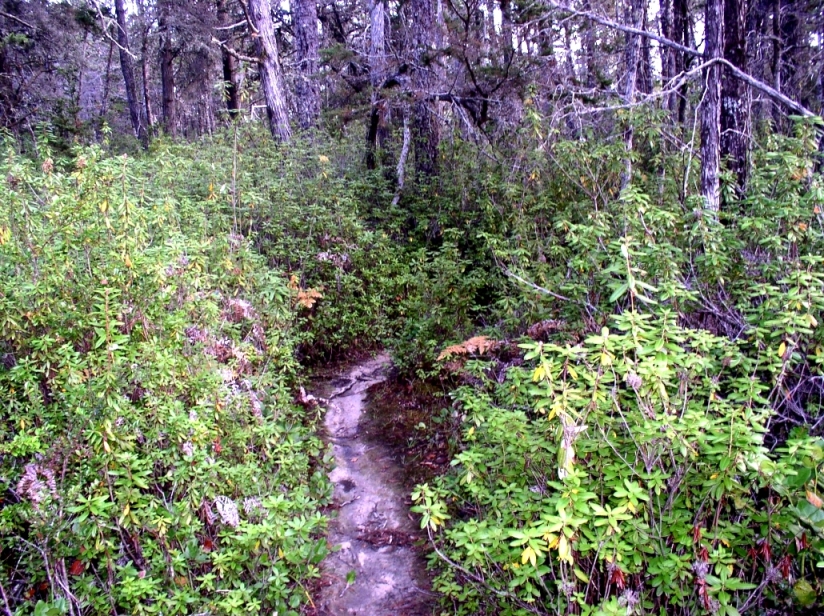
|
I, and many acquaintances who have lived in the pygmy forest have stories to tell about getting lost only 50 yards from home. Every couple of years a search and rescue team is dispatched, making news about another rescue in the pygmy forest. It is fortunate indeed, that there are several well marked pygmy forest trails for visitors to explore in the area. These are in Van Damme, Russian Gulch and Jug Handle State Parks.
My own appreciation for the pygmy forest cannot be quantified by soil analysis, geographic record or botanical survey because there are so many types of beauty to be discovered there. One is the peace of mind and serenity that comes from solitude. The pygmy forest is a quiet place. There are few birds singing, distant traffic noise is muffled and encounters with animals or other people are rare, leaving each alone to his or her thoughts. A closely related beauty is to be found if one is able to see through the mass of brambly thickets of cypress and rhododendron stalks to the classic bonasi-esqe shapes and contortions that individual pine and cypress trees have adopted in their struggle to survive. This is an Oriental or Zen like beauty. There is also a patriotic kind beauty. Just as the raising of a battle-tattered flag and bombs bursting in air on the 4th of July is beautiful to some, the sight of the beseiged and battered plants, as they fight against odds to survive, is a beautiful story of victory.
The beauty of the pygmy forest is born of our limitless imagination. As we walk like giants through the land of pygmys we must behave, as Gulliver did in the land of Lilliput, with care and sensitivity.Next time: Where is the Pygmy Forest
A "Rediscovering Charlotte M. Hoak Pygmy Forest" event is set to take place on September 10,
2016.
Related Content:
Copyright © Joshua Lowell 2015